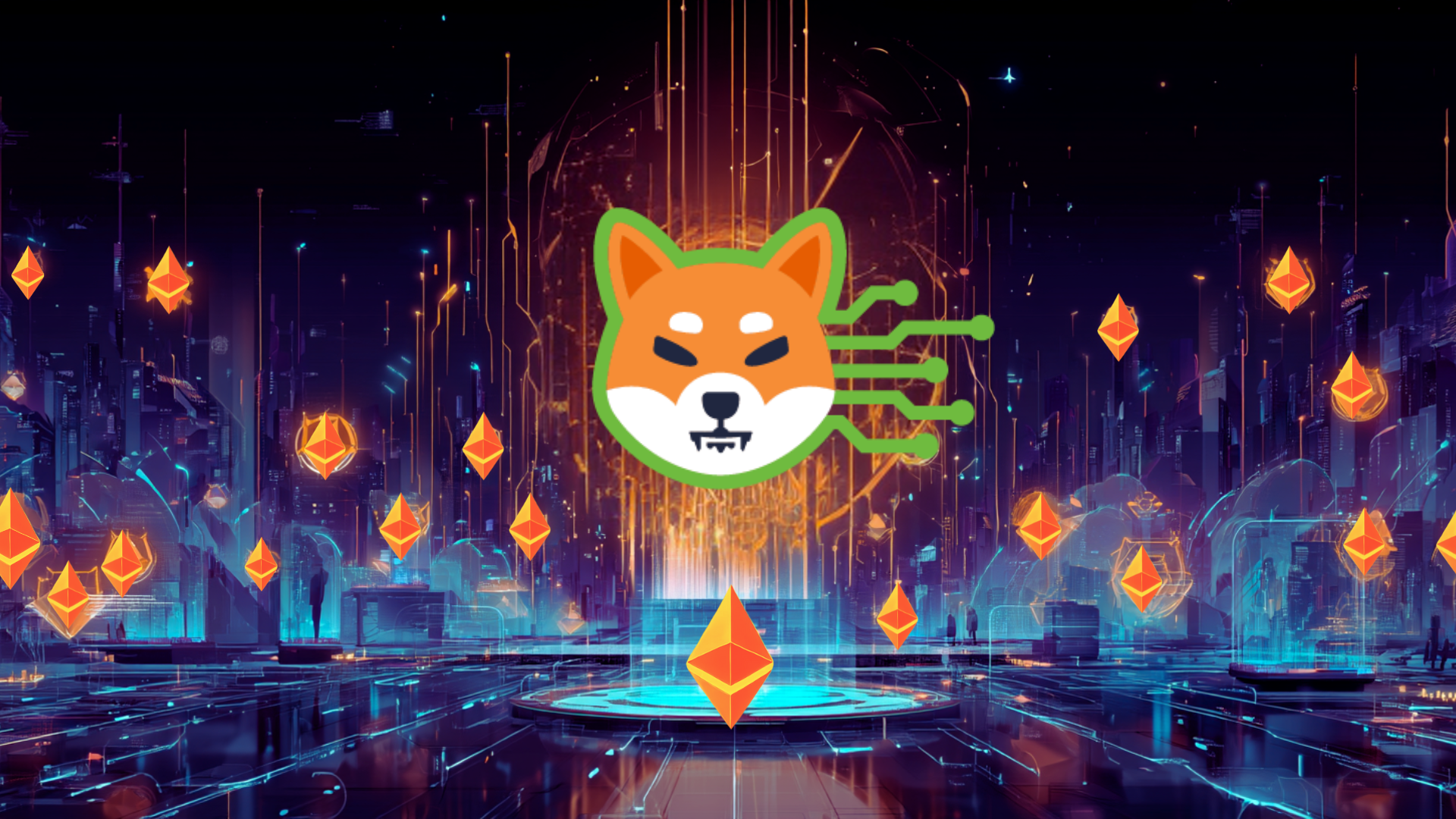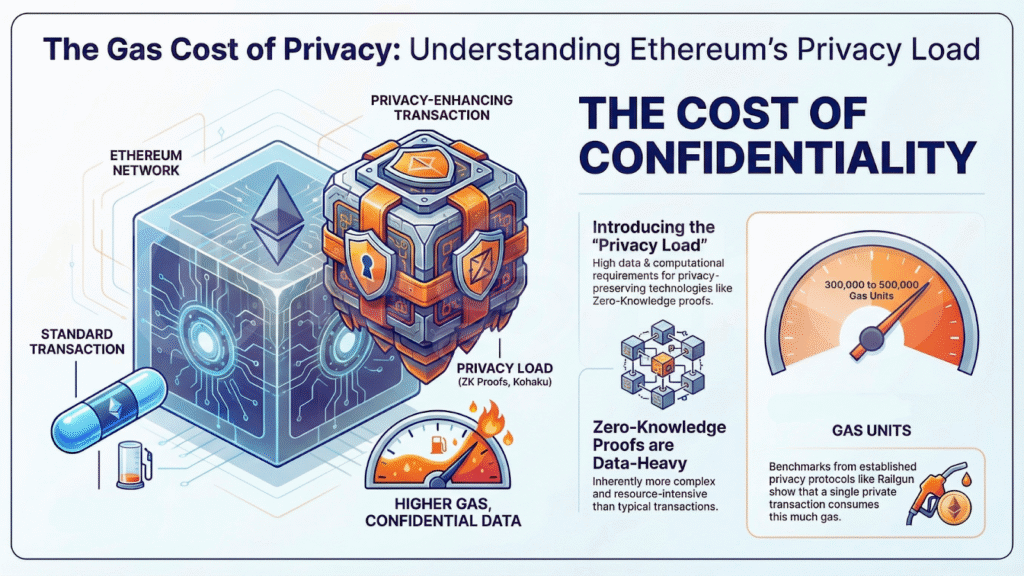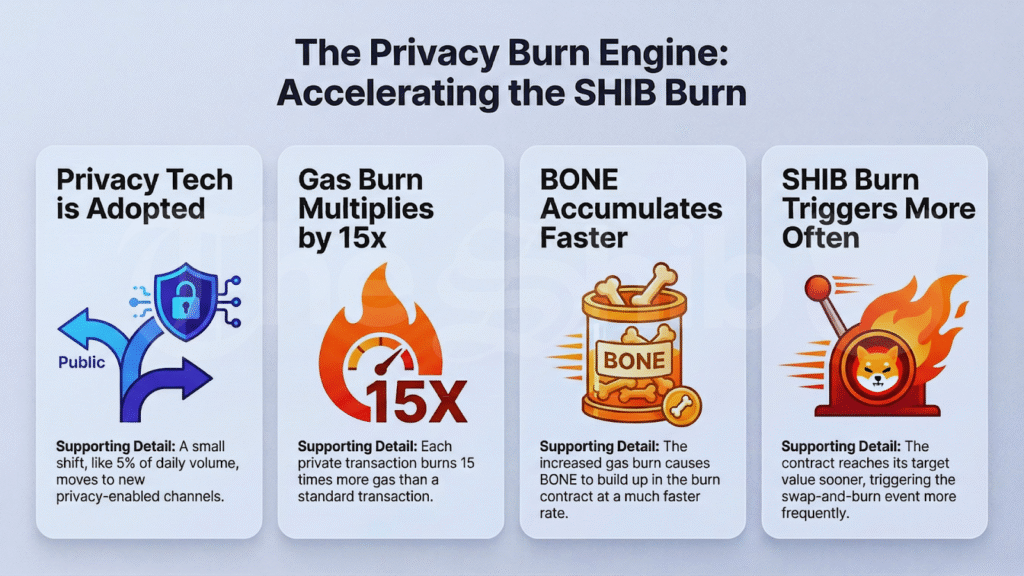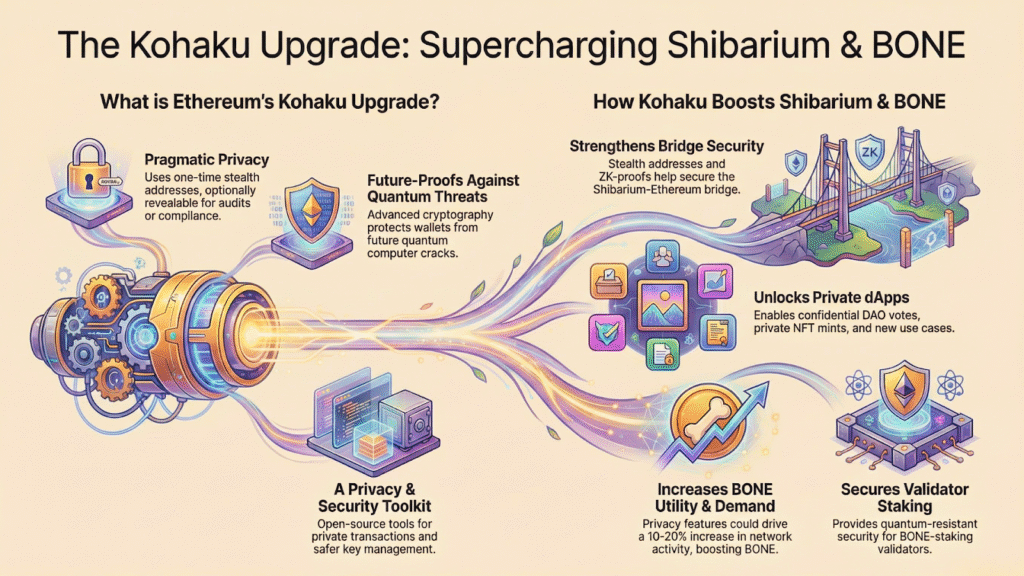
Vitalik Buterin stands before a packed hall at Devcon 2025 and unveils the Kohaku upgrade, a modular privacy framework that fortifies Ethereum against the looming threat of quantum computing while enabling Layer-2 networks like Shibarium to process confidential transactions at scale.
While the technical crowd focused on encryption standards, the implications for the Shiba Inu ecosystem were economic. Shibarium has processed over 1.5 billion transactions since launching in 2023, but it now sits at a crossroads.
Integrating Kohaku offers a dual benefit: it secures the network against the “2028 Quantum Deadline” and radically alters the utility of BONE. By introducing privacy features that demand heavy computation, the upgrade effectively rewrites the supply dynamics of the network’s gas token.
The urgency driving the Kohaku upgrade is mathematical. In a March 9, 2024, research post titled “How to save Ethereum from a quantum attack,” Buterin detailed the vulnerability of the Elliptic Curve Digital Signature Algorithm (ECDSA). This cryptographic standard secures every wallet on Ethereum and on Shibarium.
At this year’s Devcon, the Ethereum Foundation updated its risk assessment. They projected that quantum computers capable of cracking ECDSA keys could be operational by 2028.
“We are building the roof before the rain starts,” Buterin told the assembly. The Kohaku upgrade operationalizes “Post-Quantum” signatures, specifically implementing Dilithium algorithms. This creates a new operational reality for Shibarium validators staking 10,000 BONE. To keep assets like SHIB, LEASH, and TREAT secure against future threats, inheriting this infrastructure becomes less of a choice and more of a requirement for survival.
To understand the magnitude of this shift, consider the infrastructure logic. If the Ethereum base layer is a secure bank vault, historically, using a private layer like Railgun or Privacy Pools was like having to build a separate, complex underground tunnel every time a user wanted to move money secretly.
The Kohaku upgrade functions as the introduction of a universal, state-of-the-art ATM built directly into the vault itself. It manages special keys, flags large withdrawal risks, and seamlessly routes funds through those pre-existing tunnels when the user presses the “private” button. This integration ensures simplicity, safety, and regulatory compliance without requiring the user to be a cryptographer.
While security drives the upgrade, the economic implications for Bone ShibaSwap (BONE) are what capture the attention of financial analysts. The technical heart of the Kohaku upgrade is the ERC-5564 Stealth Address standard. This protocol allows users to transact without linking their public identity to the transfer.
However, crypto privacy on a public ledger is computationally expensive. On Shibarium, that computation is paid for in BONE.
To understand the potential impact on price and supply, one must examine the gas schedule:
This discrepancy creates a specific economic lever. If Shibarium integrates these privacy standards, a single private transaction utilizes the network resources of roughly 15 to 20 standard transfers. This shifts BONE from a simple toll token into the fuel for high-value cryptographic computation.

The downstream effect of this increased gas consumption hits the Shiba Inu burn mechanism directly. The ecosystem’s protocol dictates that the “base fee” portion of every transaction is locked in a smart contract.
Once this contract accumulates a specific value in BONE, it is programmatically swapped for Shiba Inu ($SHIB). That SHIB is then sent to a dead wallet to remove it from circulation.
Under the current model, triggering a burn requires millions of low-cost transactions. The Kohaku upgrade changes the input variables.
In this model, value is driven not merely by user growth but by utility density. A privacy-first Shibarium extracts more value per block than a transparent one, which directly benefits the deflationary goals of the Shiba Inu ecosystem.

The integration of privacy features often invites regulatory friction. The U.S. Treasury’s sanctions against mixers in the past demonstrated the risks of unchecked anonymity.
However, the Kohaku upgrade integrates the “Privacy Pools” concept. This was co-authored by Buterin, Ameen Soleimani, and Jacob Illum.
Privacy Pools allow users to generate cryptographic proof that their funds are not linked to illicit sources, such as known hacker wallets, without revealing their full transaction history.
For a network like Shibarium, adopting this standard creates a path toward “clean privacy.” This feature set is critical for institutional investors who require confidentiality to protect trade strategies but must remain compliant with global Anti-Money Laundering (AML) laws.
By embedding compliance directly into the privacy protocol, the network can serve high-volume commercial users who were previously barred by internal risk controls.
Implementation, however, is where the rubber meets the road. Unlike Layer-2 rollups that might inherit Ethereum’s changes automatically, Shibarium’s sidechain architecture requires manual intervention.
The development team cannot simply wait for the upgrade to trickle down; they must actively fork the Privacy SDK and tailor it to the network’s Heimdall and Bor nodes.
This is a complex engineering hurdle. Getting mobile wallets to generate cryptographic proofs efficiently is difficult, as is tuning validator nodes to process data-heavy privacy blocks without lagging. But the market has already tipped its hand. The sector-wide rally in privacy tokens following the announcement suggests that the demand for confidential infrastructure outweighs the technical difficulty of building it.

The path forward is paved with engineering challenges, but the destination offers a prize rarely seen in the cryptocurrency sector: longevity.
The “2028 Quantum Deadline” is not merely a technical hurdle. It is a filter. Blockchains that fail to adapt to the post-quantum era risk becoming digital relics, while those that evolve will secure their place in the next generation of finance. For Shibarium, the Kohaku upgrade represents the difference between remaining a popular meme-coin sidechain and becoming a foundational layer for privacy-preserving commerce.
The infrastructure is ready. The economic incentives for BONE are mathematically sound. The regulatory framework is compliant. Now, the variable is will.
This is where the unique structure of the Shiba Inu ecosystem becomes its greatest asset. Through the Doggy DAO, the community holds the governance power to prioritize this integration.
The question is no longer whether Shibarium can become the most private, secure, and deflationary network in the industry. The question is whether its developers and its army will choose to build the roof before the rain begins.
The quantum clock is ticking. It is time to decide what the future of Shibarium looks like.
NOTE: The Shiba Inu ecosystem has previously announced an FHE-enabled L3 privacy layer, along with additional initiatives tied to its partnership with ZAMA. These components remain under active development. How this future stack ultimately aligns with, or remains independent from, the privacy primitives introduced through the Kohaku upgrade will be determined by the Shiba Inu development team and broader DAO governance. This feature article is positioned as a scenario assessment of the potential economic and operational impacts should the network choose to leverage Ethereum’s emerging privacy and post-quantum capabilities.

Yona brings a decade of experience covering gaming, tech, and blockchain news. As one of the few women in crypto journalism, her mission is to demystify complex technical subjects for a wider audience. Her work blends professional insight with engaging narratives, aiming to educate and entertain.